Application of Economic Theories and Concept
VerifiedAdded on 2021/05/31
|9
|1495
|117
AI Summary
Contribute Materials
Your contribution can guide someone’s learning journey. Share your
documents today.
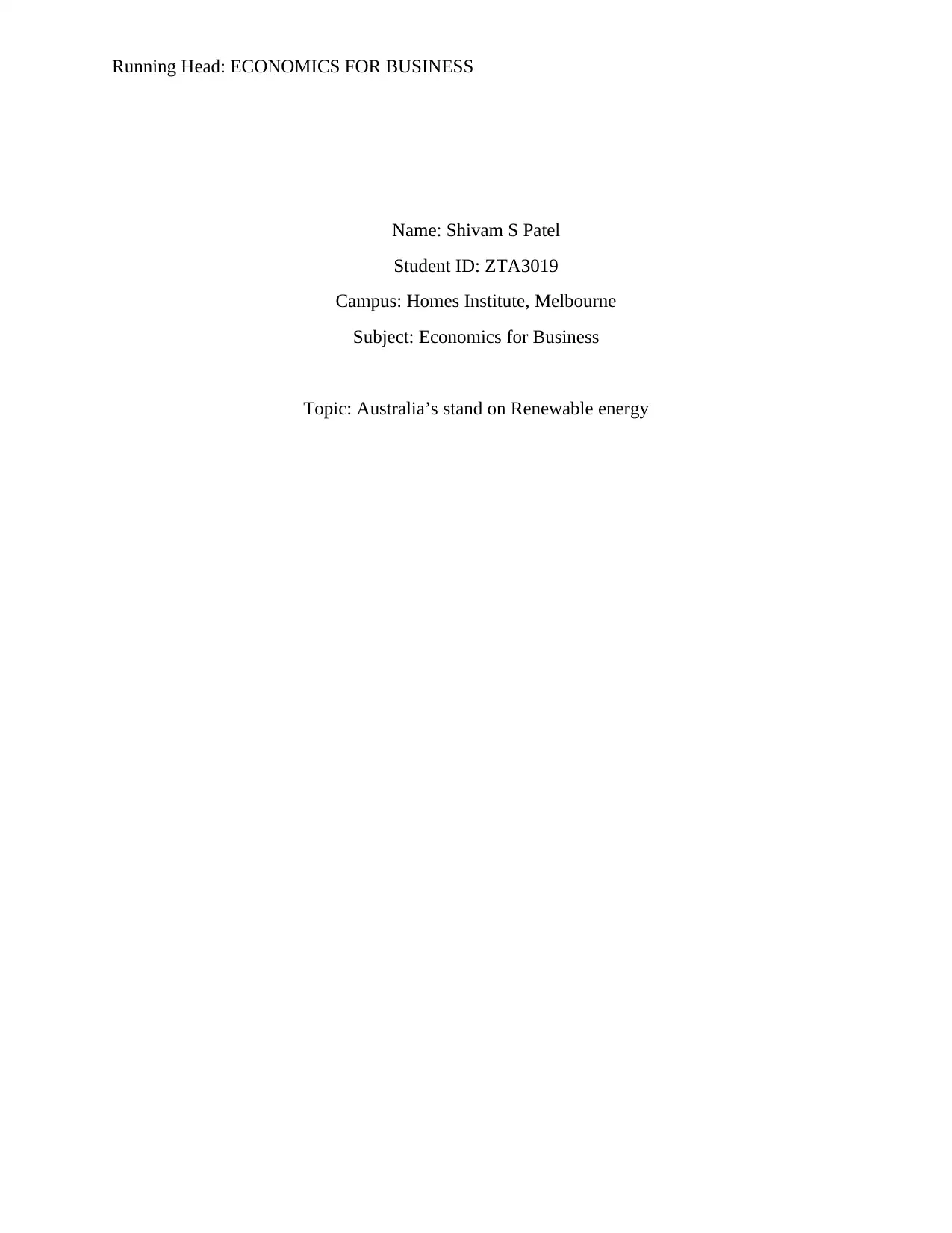
Running Head: ECONOMICS FOR BUSINESS
Name: Shivam S Patel
Student ID: ZTA3019
Campus: Homes Institute, Melbourne
Subject: Economics for Business
Topic: Australia’s stand on Renewable energy
Name: Shivam S Patel
Student ID: ZTA3019
Campus: Homes Institute, Melbourne
Subject: Economics for Business
Topic: Australia’s stand on Renewable energy
Secure Best Marks with AI Grader
Need help grading? Try our AI Grader for instant feedback on your assignments.
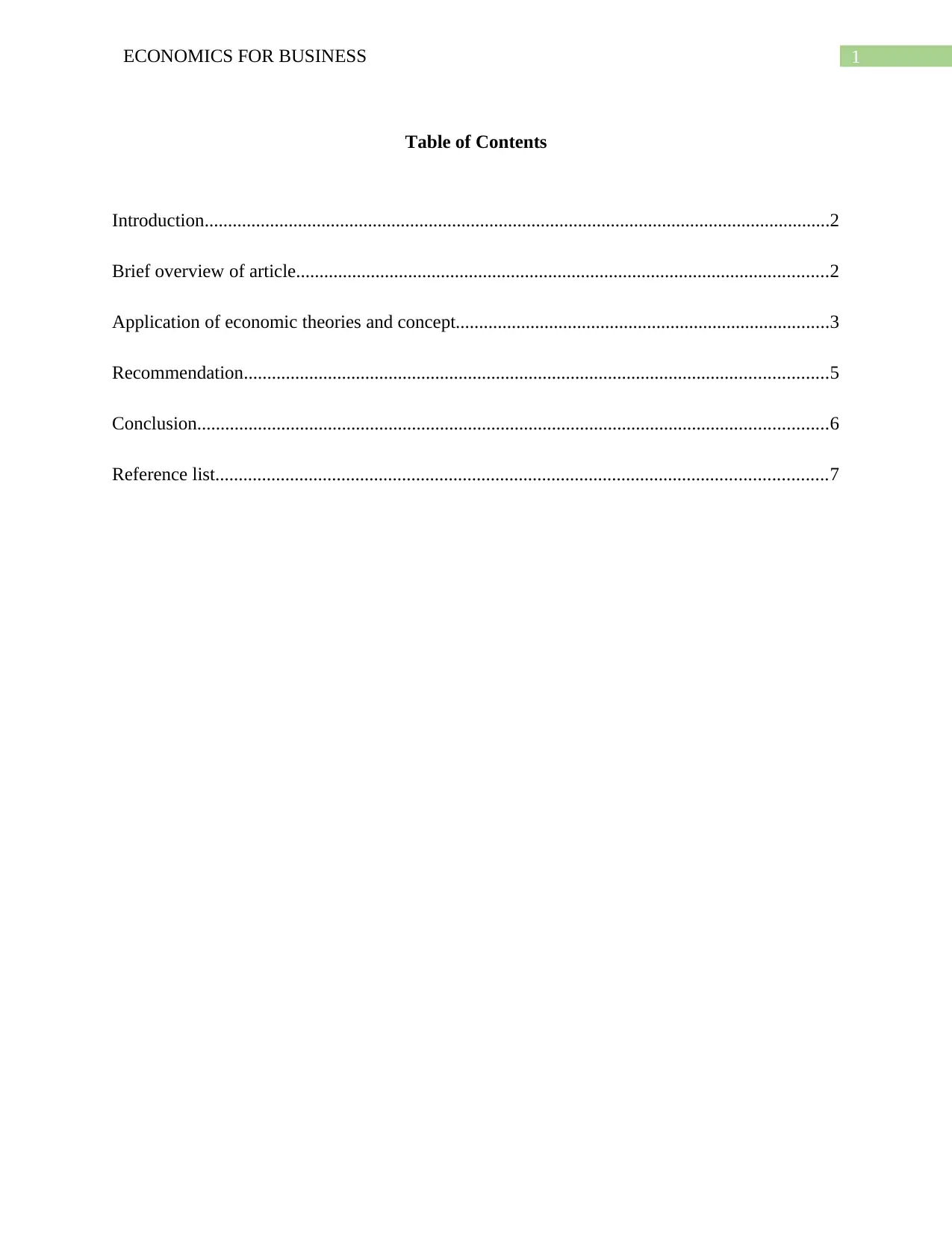
1ECONOMICS FOR BUSINESS
Table of Contents
Introduction......................................................................................................................................2
Brief overview of article..................................................................................................................2
Application of economic theories and concept................................................................................3
Recommendation.............................................................................................................................5
Conclusion.......................................................................................................................................6
Reference list...................................................................................................................................7
Table of Contents
Introduction......................................................................................................................................2
Brief overview of article..................................................................................................................2
Application of economic theories and concept................................................................................3
Recommendation.............................................................................................................................5
Conclusion.......................................................................................................................................6
Reference list...................................................................................................................................7
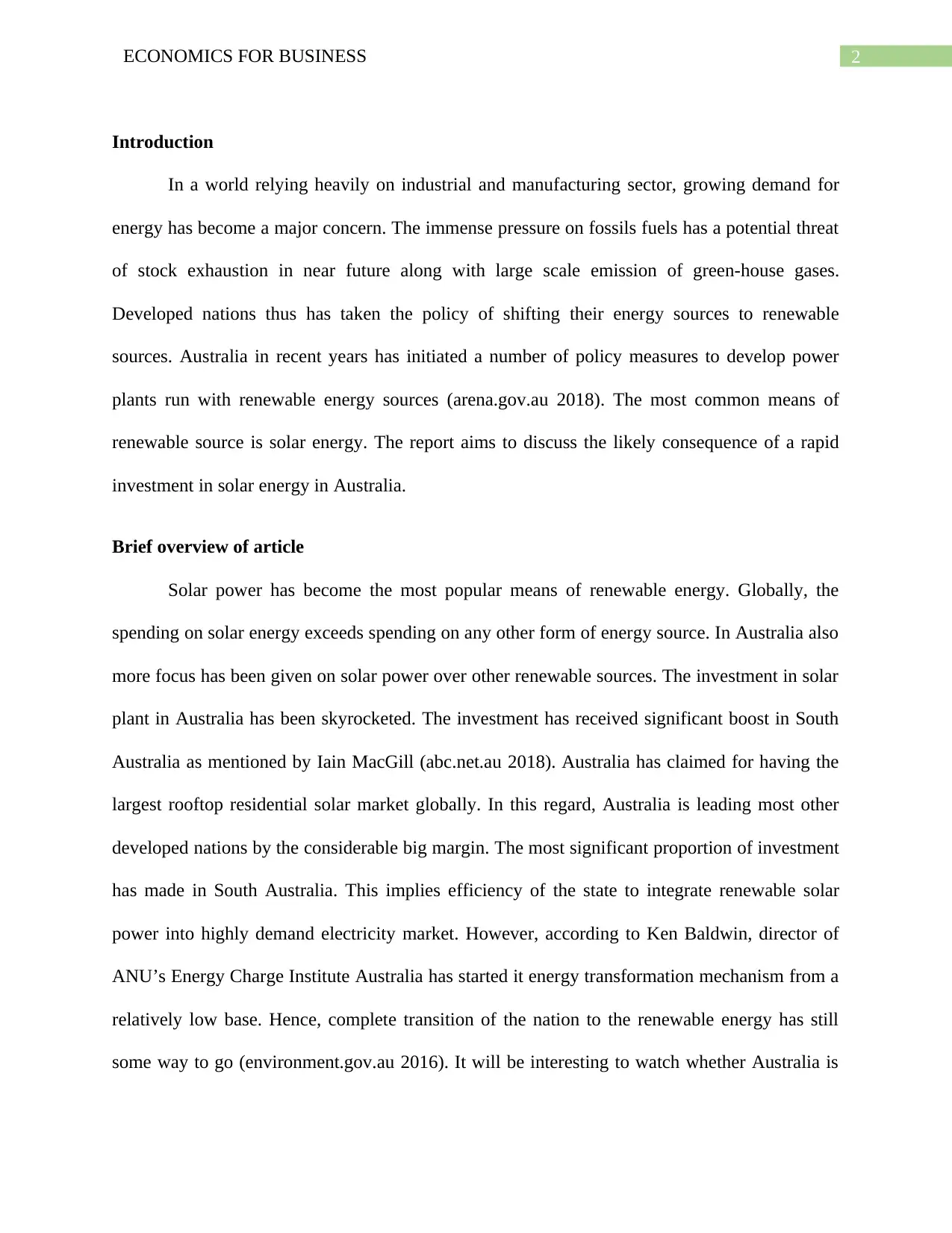
2ECONOMICS FOR BUSINESS
Introduction
In a world relying heavily on industrial and manufacturing sector, growing demand for
energy has become a major concern. The immense pressure on fossils fuels has a potential threat
of stock exhaustion in near future along with large scale emission of green-house gases.
Developed nations thus has taken the policy of shifting their energy sources to renewable
sources. Australia in recent years has initiated a number of policy measures to develop power
plants run with renewable energy sources (arena.gov.au 2018). The most common means of
renewable source is solar energy. The report aims to discuss the likely consequence of a rapid
investment in solar energy in Australia.
Brief overview of article
Solar power has become the most popular means of renewable energy. Globally, the
spending on solar energy exceeds spending on any other form of energy source. In Australia also
more focus has been given on solar power over other renewable sources. The investment in solar
plant in Australia has been skyrocketed. The investment has received significant boost in South
Australia as mentioned by Iain MacGill (abc.net.au 2018). Australia has claimed for having the
largest rooftop residential solar market globally. In this regard, Australia is leading most other
developed nations by the considerable big margin. The most significant proportion of investment
has made in South Australia. This implies efficiency of the state to integrate renewable solar
power into highly demand electricity market. However, according to Ken Baldwin, director of
ANU’s Energy Charge Institute Australia has started it energy transformation mechanism from a
relatively low base. Hence, complete transition of the nation to the renewable energy has still
some way to go (environment.gov.au 2016). It will be interesting to watch whether Australia is
Introduction
In a world relying heavily on industrial and manufacturing sector, growing demand for
energy has become a major concern. The immense pressure on fossils fuels has a potential threat
of stock exhaustion in near future along with large scale emission of green-house gases.
Developed nations thus has taken the policy of shifting their energy sources to renewable
sources. Australia in recent years has initiated a number of policy measures to develop power
plants run with renewable energy sources (arena.gov.au 2018). The most common means of
renewable source is solar energy. The report aims to discuss the likely consequence of a rapid
investment in solar energy in Australia.
Brief overview of article
Solar power has become the most popular means of renewable energy. Globally, the
spending on solar energy exceeds spending on any other form of energy source. In Australia also
more focus has been given on solar power over other renewable sources. The investment in solar
plant in Australia has been skyrocketed. The investment has received significant boost in South
Australia as mentioned by Iain MacGill (abc.net.au 2018). Australia has claimed for having the
largest rooftop residential solar market globally. In this regard, Australia is leading most other
developed nations by the considerable big margin. The most significant proportion of investment
has made in South Australia. This implies efficiency of the state to integrate renewable solar
power into highly demand electricity market. However, according to Ken Baldwin, director of
ANU’s Energy Charge Institute Australia has started it energy transformation mechanism from a
relatively low base. Hence, complete transition of the nation to the renewable energy has still
some way to go (environment.gov.au 2016). It will be interesting to watch whether Australia is

3ECONOMICS FOR BUSINESS
able to maintain the pace of renewable energy development. There have been an estimated 6
gigawatts of solar power installed in Australia including both commercial and residential units.
Solar energy in combination with wind power generation is expected to completely
replace the coal fired power plants by next one or two decade. Worldwide the share of electricity
generated from renewable sources such as solar, wind, geothermal, waste to energy, marine and
small hydro increased from 11 percent to 12.1 percent in 2017 (abc.net.au 2018). During this
year Australia has accounted a record investment of $8.5 billion. The investment in renewable
energy has generated a greater return for the invested money as compared to that in few years
back. Per watt price of solar photovoltaic was just $1.40 in 2017 in contrast to a price of $6.40 in
2010. The investment in solar energy though has increased but concern remain regarding the
policy uncertainty of government.
Application of economic theories and concept
In response to large scale pollution globally mostly generated from use of fossils-fuel,
advanced nations now have set to achieve a clean energy target. A policy adapted by nations to
reduce carbon emission to a low level. In order to achieve the target of clean energy Australia
has made a radical shift from traditional to renewable sources of energy
(cleanenergycouncil.org.au 2018). In the phase of transition Australia have faced a major
challenge in form of rapidly increasing price of electricity.
Demand and supply are the key drivers of price in a market (Melvin and Boyes 2013).
Despite having world’s largest stock of coal and natural gas along with favorable condition of
clean power generation Australia has initially faced a problem of power shortage. Natural gas
was expected to fill the supply gap created from the close down of traditional coal plants with a
able to maintain the pace of renewable energy development. There have been an estimated 6
gigawatts of solar power installed in Australia including both commercial and residential units.
Solar energy in combination with wind power generation is expected to completely
replace the coal fired power plants by next one or two decade. Worldwide the share of electricity
generated from renewable sources such as solar, wind, geothermal, waste to energy, marine and
small hydro increased from 11 percent to 12.1 percent in 2017 (abc.net.au 2018). During this
year Australia has accounted a record investment of $8.5 billion. The investment in renewable
energy has generated a greater return for the invested money as compared to that in few years
back. Per watt price of solar photovoltaic was just $1.40 in 2017 in contrast to a price of $6.40 in
2010. The investment in solar energy though has increased but concern remain regarding the
policy uncertainty of government.
Application of economic theories and concept
In response to large scale pollution globally mostly generated from use of fossils-fuel,
advanced nations now have set to achieve a clean energy target. A policy adapted by nations to
reduce carbon emission to a low level. In order to achieve the target of clean energy Australia
has made a radical shift from traditional to renewable sources of energy
(cleanenergycouncil.org.au 2018). In the phase of transition Australia have faced a major
challenge in form of rapidly increasing price of electricity.
Demand and supply are the key drivers of price in a market (Melvin and Boyes 2013).
Despite having world’s largest stock of coal and natural gas along with favorable condition of
clean power generation Australia has initially faced a problem of power shortage. Natural gas
was expected to fill the supply gap created from the close down of traditional coal plants with a
Secure Best Marks with AI Grader
Need help grading? Try our AI Grader for instant feedback on your assignments.
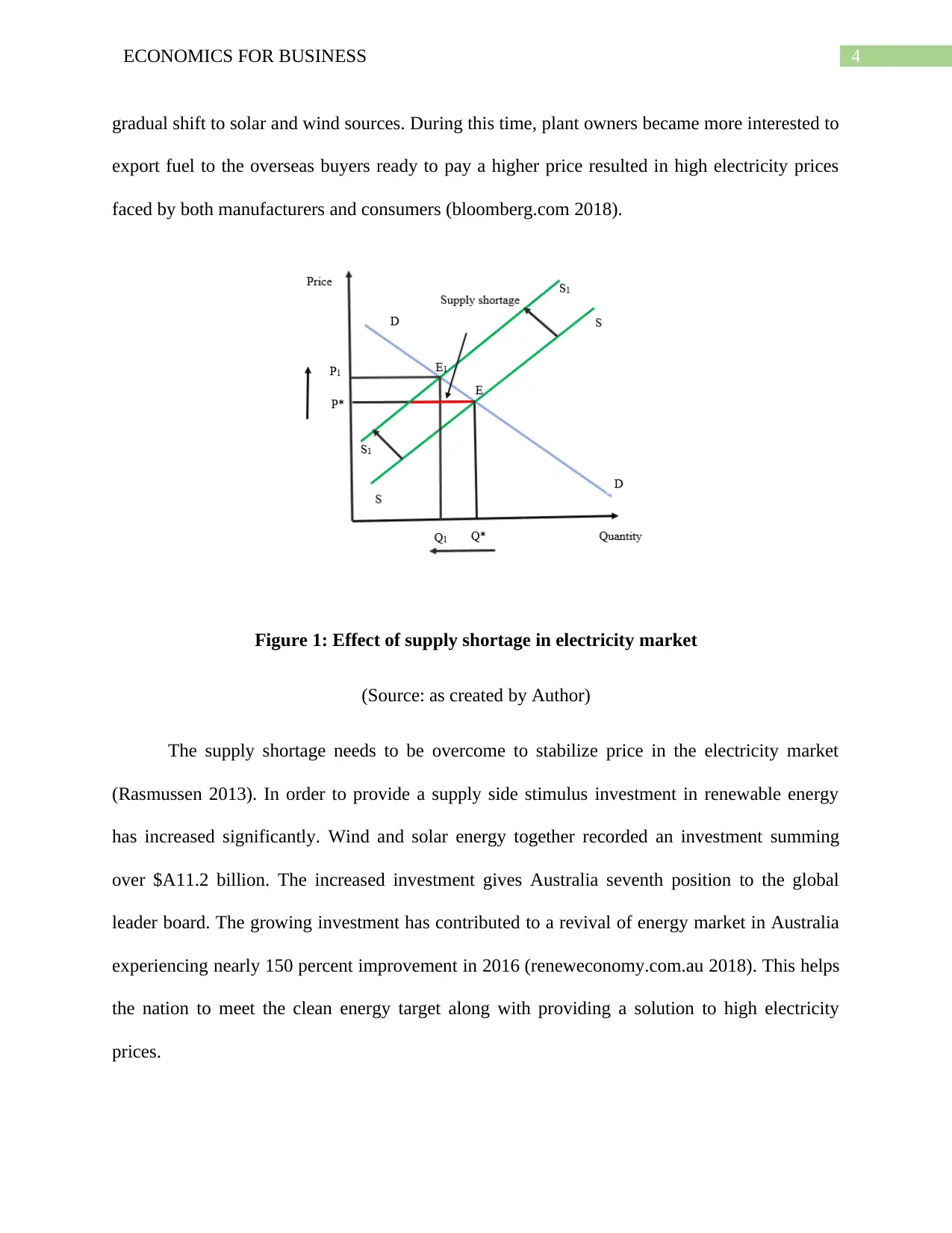
4ECONOMICS FOR BUSINESS
gradual shift to solar and wind sources. During this time, plant owners became more interested to
export fuel to the overseas buyers ready to pay a higher price resulted in high electricity prices
faced by both manufacturers and consumers (bloomberg.com 2018).
Figure 1: Effect of supply shortage in electricity market
(Source: as created by Author)
The supply shortage needs to be overcome to stabilize price in the electricity market
(Rasmussen 2013). In order to provide a supply side stimulus investment in renewable energy
has increased significantly. Wind and solar energy together recorded an investment summing
over $A11.2 billion. The increased investment gives Australia seventh position to the global
leader board. The growing investment has contributed to a revival of energy market in Australia
experiencing nearly 150 percent improvement in 2016 (reneweconomy.com.au 2018). This helps
the nation to meet the clean energy target along with providing a solution to high electricity
prices.
gradual shift to solar and wind sources. During this time, plant owners became more interested to
export fuel to the overseas buyers ready to pay a higher price resulted in high electricity prices
faced by both manufacturers and consumers (bloomberg.com 2018).
Figure 1: Effect of supply shortage in electricity market
(Source: as created by Author)
The supply shortage needs to be overcome to stabilize price in the electricity market
(Rasmussen 2013). In order to provide a supply side stimulus investment in renewable energy
has increased significantly. Wind and solar energy together recorded an investment summing
over $A11.2 billion. The increased investment gives Australia seventh position to the global
leader board. The growing investment has contributed to a revival of energy market in Australia
experiencing nearly 150 percent improvement in 2016 (reneweconomy.com.au 2018). This helps
the nation to meet the clean energy target along with providing a solution to high electricity
prices.
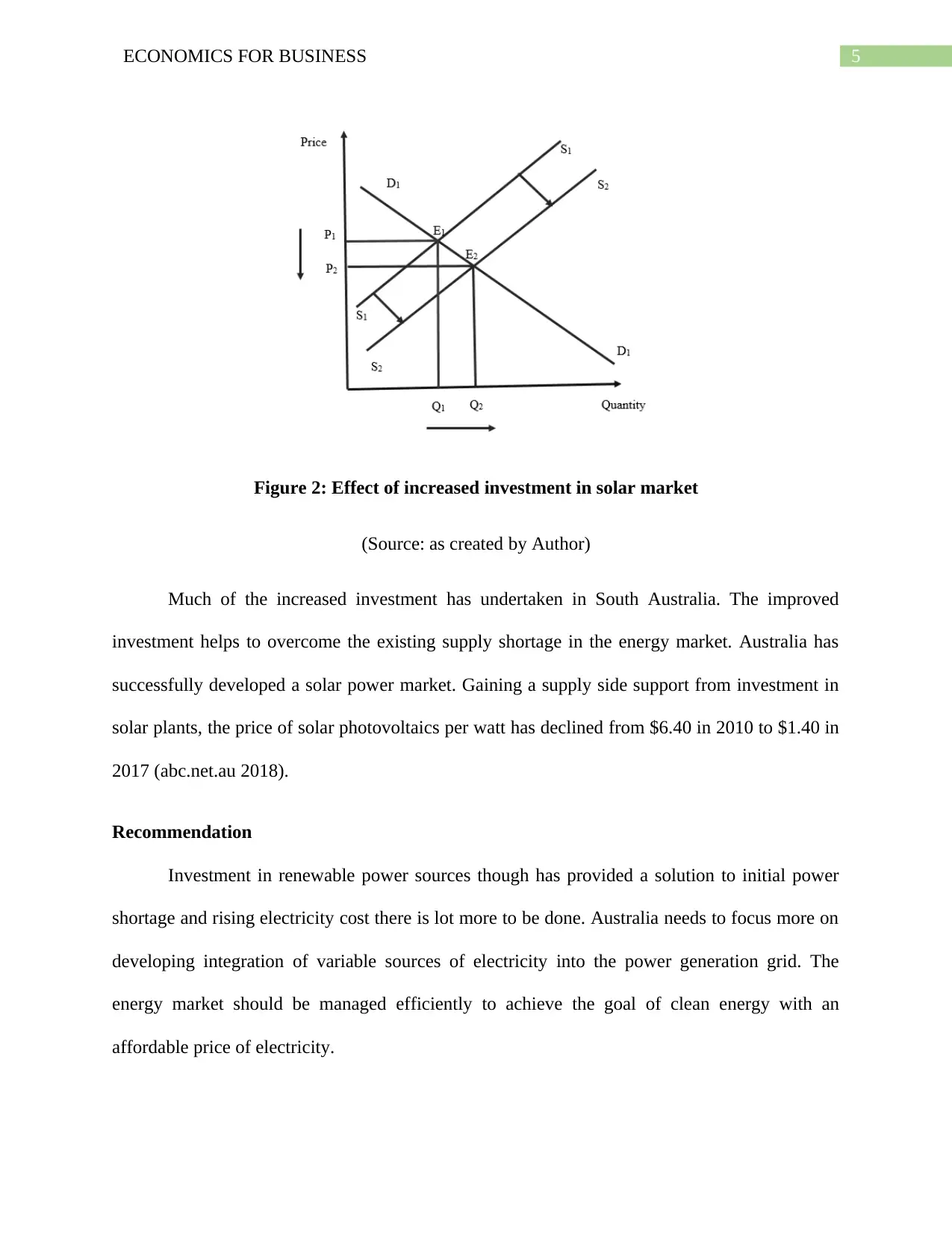
5ECONOMICS FOR BUSINESS
Figure 2: Effect of increased investment in solar market
(Source: as created by Author)
Much of the increased investment has undertaken in South Australia. The improved
investment helps to overcome the existing supply shortage in the energy market. Australia has
successfully developed a solar power market. Gaining a supply side support from investment in
solar plants, the price of solar photovoltaics per watt has declined from $6.40 in 2010 to $1.40 in
2017 (abc.net.au 2018).
Recommendation
Investment in renewable power sources though has provided a solution to initial power
shortage and rising electricity cost there is lot more to be done. Australia needs to focus more on
developing integration of variable sources of electricity into the power generation grid. The
energy market should be managed efficiently to achieve the goal of clean energy with an
affordable price of electricity.
Figure 2: Effect of increased investment in solar market
(Source: as created by Author)
Much of the increased investment has undertaken in South Australia. The improved
investment helps to overcome the existing supply shortage in the energy market. Australia has
successfully developed a solar power market. Gaining a supply side support from investment in
solar plants, the price of solar photovoltaics per watt has declined from $6.40 in 2010 to $1.40 in
2017 (abc.net.au 2018).
Recommendation
Investment in renewable power sources though has provided a solution to initial power
shortage and rising electricity cost there is lot more to be done. Australia needs to focus more on
developing integration of variable sources of electricity into the power generation grid. The
energy market should be managed efficiently to achieve the goal of clean energy with an
affordable price of electricity.
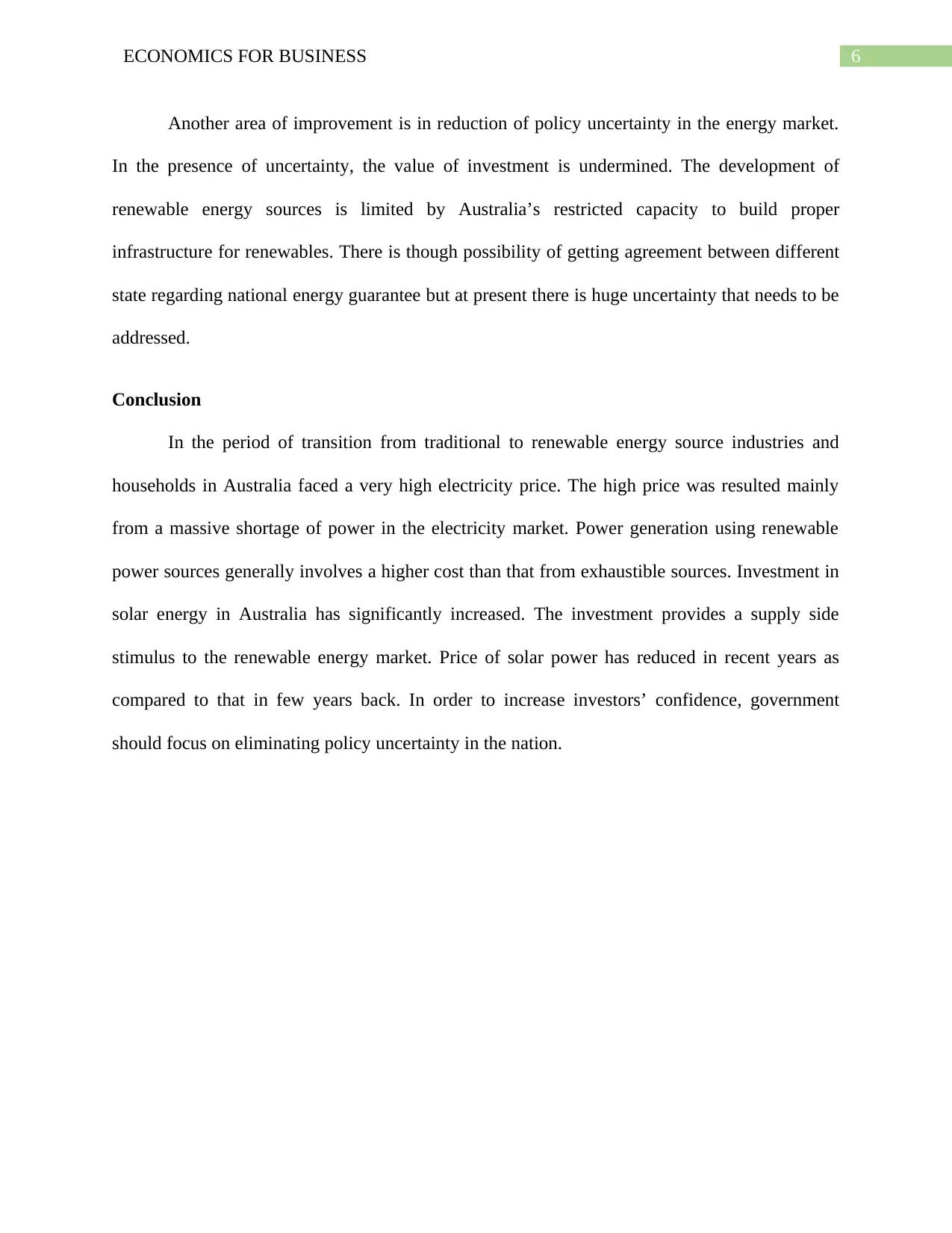
6ECONOMICS FOR BUSINESS
Another area of improvement is in reduction of policy uncertainty in the energy market.
In the presence of uncertainty, the value of investment is undermined. The development of
renewable energy sources is limited by Australia’s restricted capacity to build proper
infrastructure for renewables. There is though possibility of getting agreement between different
state regarding national energy guarantee but at present there is huge uncertainty that needs to be
addressed.
Conclusion
In the period of transition from traditional to renewable energy source industries and
households in Australia faced a very high electricity price. The high price was resulted mainly
from a massive shortage of power in the electricity market. Power generation using renewable
power sources generally involves a higher cost than that from exhaustible sources. Investment in
solar energy in Australia has significantly increased. The investment provides a supply side
stimulus to the renewable energy market. Price of solar power has reduced in recent years as
compared to that in few years back. In order to increase investors’ confidence, government
should focus on eliminating policy uncertainty in the nation.
Another area of improvement is in reduction of policy uncertainty in the energy market.
In the presence of uncertainty, the value of investment is undermined. The development of
renewable energy sources is limited by Australia’s restricted capacity to build proper
infrastructure for renewables. There is though possibility of getting agreement between different
state regarding national energy guarantee but at present there is huge uncertainty that needs to be
addressed.
Conclusion
In the period of transition from traditional to renewable energy source industries and
households in Australia faced a very high electricity price. The high price was resulted mainly
from a massive shortage of power in the electricity market. Power generation using renewable
power sources generally involves a higher cost than that from exhaustible sources. Investment in
solar energy in Australia has significantly increased. The investment provides a supply side
stimulus to the renewable energy market. Price of solar power has reduced in recent years as
compared to that in few years back. In order to increase investors’ confidence, government
should focus on eliminating policy uncertainty in the nation.
Paraphrase This Document
Need a fresh take? Get an instant paraphrase of this document with our AI Paraphraser
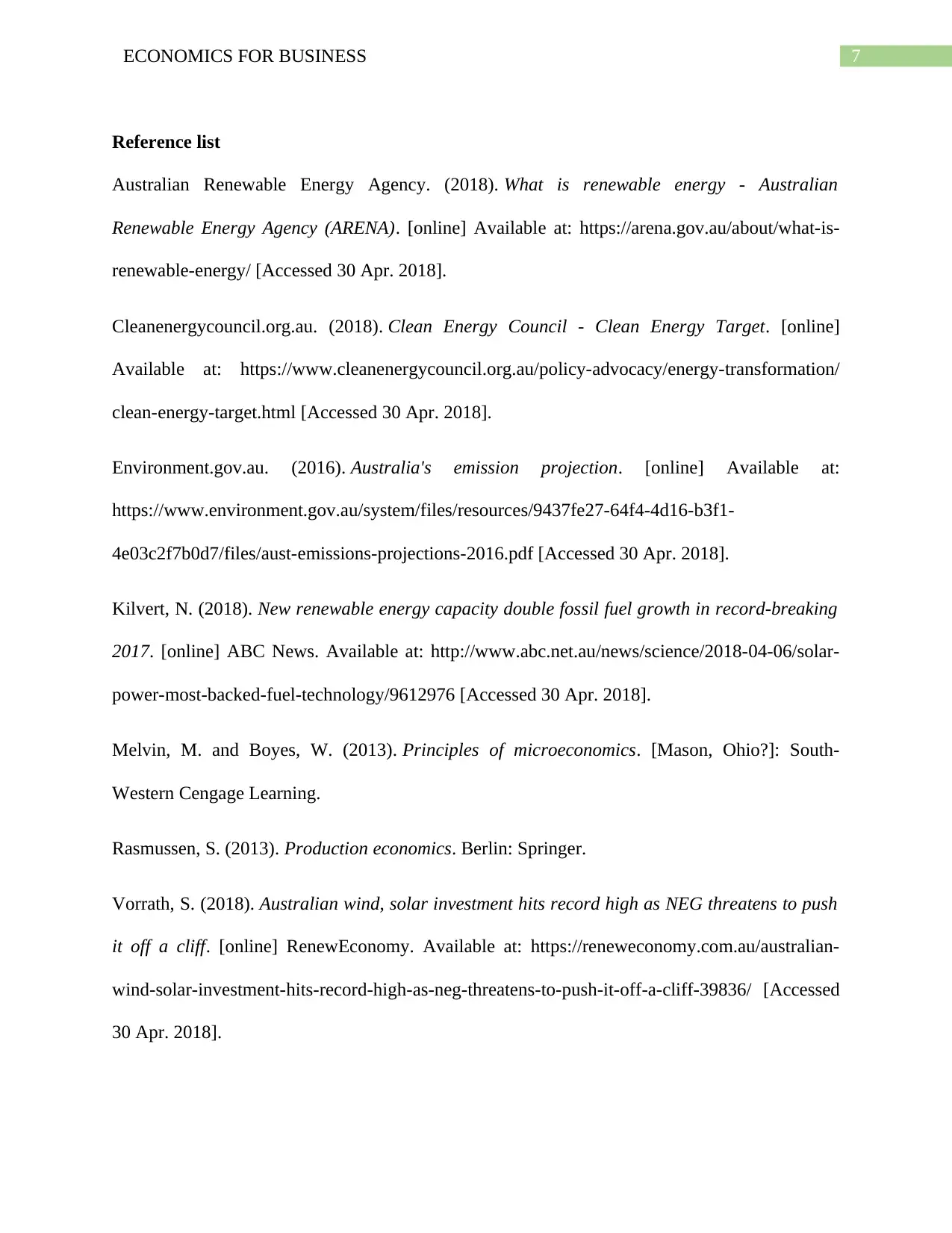
7ECONOMICS FOR BUSINESS
Reference list
Australian Renewable Energy Agency. (2018). What is renewable energy - Australian
Renewable Energy Agency (ARENA). [online] Available at: https://arena.gov.au/about/what-is-
renewable-energy/ [Accessed 30 Apr. 2018].
Cleanenergycouncil.org.au. (2018). Clean Energy Council - Clean Energy Target. [online]
Available at: https://www.cleanenergycouncil.org.au/policy-advocacy/energy-transformation/
clean-energy-target.html [Accessed 30 Apr. 2018].
Environment.gov.au. (2016). Australia's emission projection. [online] Available at:
https://www.environment.gov.au/system/files/resources/9437fe27-64f4-4d16-b3f1-
4e03c2f7b0d7/files/aust-emissions-projections-2016.pdf [Accessed 30 Apr. 2018].
Kilvert, N. (2018). New renewable energy capacity double fossil fuel growth in record-breaking
2017. [online] ABC News. Available at: http://www.abc.net.au/news/science/2018-04-06/solar-
power-most-backed-fuel-technology/9612976 [Accessed 30 Apr. 2018].
Melvin, M. and Boyes, W. (2013). Principles of microeconomics. [Mason, Ohio?]: South-
Western Cengage Learning.
Rasmussen, S. (2013). Production economics. Berlin: Springer.
Vorrath, S. (2018). Australian wind, solar investment hits record high as NEG threatens to push
it off a cliff. [online] RenewEconomy. Available at: https://reneweconomy.com.au/australian-
wind-solar-investment-hits-record-high-as-neg-threatens-to-push-it-off-a-cliff-39836/ [Accessed
30 Apr. 2018].
Reference list
Australian Renewable Energy Agency. (2018). What is renewable energy - Australian
Renewable Energy Agency (ARENA). [online] Available at: https://arena.gov.au/about/what-is-
renewable-energy/ [Accessed 30 Apr. 2018].
Cleanenergycouncil.org.au. (2018). Clean Energy Council - Clean Energy Target. [online]
Available at: https://www.cleanenergycouncil.org.au/policy-advocacy/energy-transformation/
clean-energy-target.html [Accessed 30 Apr. 2018].
Environment.gov.au. (2016). Australia's emission projection. [online] Available at:
https://www.environment.gov.au/system/files/resources/9437fe27-64f4-4d16-b3f1-
4e03c2f7b0d7/files/aust-emissions-projections-2016.pdf [Accessed 30 Apr. 2018].
Kilvert, N. (2018). New renewable energy capacity double fossil fuel growth in record-breaking
2017. [online] ABC News. Available at: http://www.abc.net.au/news/science/2018-04-06/solar-
power-most-backed-fuel-technology/9612976 [Accessed 30 Apr. 2018].
Melvin, M. and Boyes, W. (2013). Principles of microeconomics. [Mason, Ohio?]: South-
Western Cengage Learning.
Rasmussen, S. (2013). Production economics. Berlin: Springer.
Vorrath, S. (2018). Australian wind, solar investment hits record high as NEG threatens to push
it off a cliff. [online] RenewEconomy. Available at: https://reneweconomy.com.au/australian-
wind-solar-investment-hits-record-high-as-neg-threatens-to-push-it-off-a-cliff-39836/ [Accessed
30 Apr. 2018].
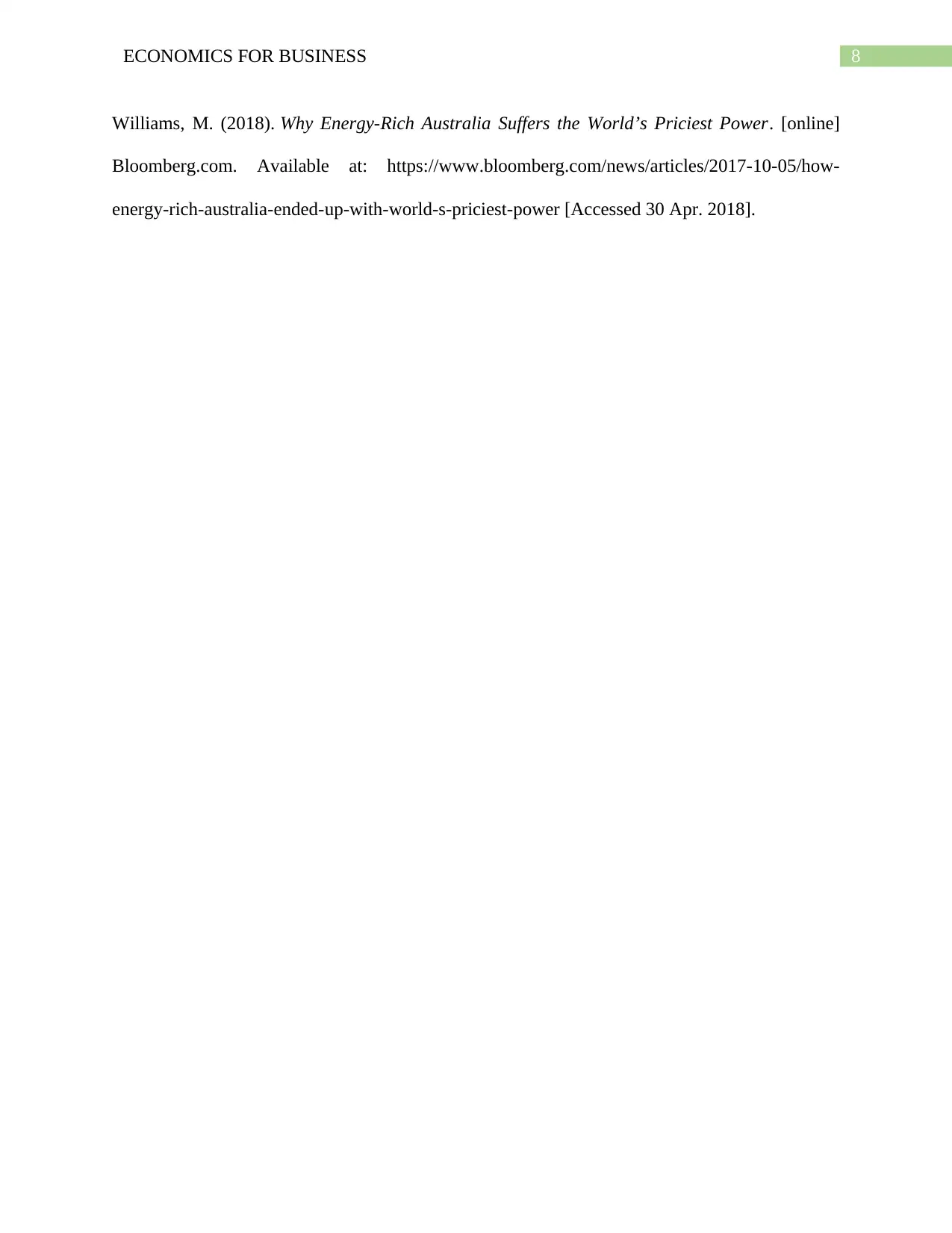
8ECONOMICS FOR BUSINESS
Williams, M. (2018). Why Energy-Rich Australia Suffers the World’s Priciest Power. [online]
Bloomberg.com. Available at: https://www.bloomberg.com/news/articles/2017-10-05/how-
energy-rich-australia-ended-up-with-world-s-priciest-power [Accessed 30 Apr. 2018].
Williams, M. (2018). Why Energy-Rich Australia Suffers the World’s Priciest Power. [online]
Bloomberg.com. Available at: https://www.bloomberg.com/news/articles/2017-10-05/how-
energy-rich-australia-ended-up-with-world-s-priciest-power [Accessed 30 Apr. 2018].
1 out of 9
Related Documents
Your All-in-One AI-Powered Toolkit for Academic Success.
+13062052269
info@desklib.com
Available 24*7 on WhatsApp / Email
![[object Object]](/_next/static/media/star-bottom.7253800d.svg)
Unlock your academic potential
© 2024 | Zucol Services PVT LTD | All rights reserved.





